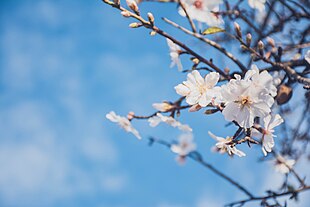Aaron's staff (Bible)
Aaron's staff is a stick from the almond tree mentioned in the Bible , which has had a diverse history of effects.
Torah
In the narrative context of the Book of Numbers (chapters 16 and 17), the authority of the Zadokid priesthood represented by Aaron is questioned several times. This creates a "vortex of deadly violence". Behind these stories is the idea that the task of the high priest , who approached the holy God, is dangerous.
The story of Aaron's greening staff finally describes ( Num. 17,16-26 LUT ) how the conflict is decided by YHWH in favor of Aarons, with which dying has an end. In Biblical Hebrew means מַטֶּה maṭṭeh both staff and tribe, because the staff in the hand of the chief is a scepter that symbolizes the tribe. This is what the narrative is based on. A stick is cut for each of the twelve tribes of Israel, inscribed with the name of the chief, and placed in the tent sanctuary in front of the ark of the testimony . Aaron is the chief of the Levites . The next morning the staff with the name Aarons not only knocked out, but also produced flowers and ripe almonds. It has become an almond tree and will in future be a symbol of the correct cultic order in the sanctuary. Chapter 17 ends with the Israelites' fear of the sacred. This is followed by a text in chapter 18 that incites the responsibility of Aaron and the high priests represented by him for "cultic security". Because of its early flowering, the almond tree is called "the vigilant" in Hebrew (שָׁקֵד), which is alluded to several times in the Old Testament, perhaps also here: Aaron is supposed to carry out his duties "in the sense of diligent vigilance".
Josephus' Jewish Antiquities
Flavius Josephus offers a retelling of biblical material ( Rewritten Bible ) in his work Jewish antiquities . The story of Aaron's blooming staff receives the following updates:
- Moses, not Aaron, is the focus;
- The narrative begins with a riot (στάσις) and ends with the restoration of peace;
- It is not Aaron's name that is written on the staff (Moses would exclude that), but: "Levit."
Rabbinic traditions

According to some interpreters, Aaron's staff with almonds and blossoms was one of the things that were created on the evening of the sixth day of creation in the twilight.
It was passed on from Adam to his son Shem, and so on from one generation of patriarchs to the next up to Joseph . After his death it came into the possession of Jethro , who planted it in his garden, where it became a tree. Since the tetragram was written on it, no one could tear out the tree until Moses came and tore it out and was allowed to marry Zippora as a reward . It then became the staff with which Moses and Aaron work miracles in the story of the Exodus.
The Midrash Bamidbar Rabba identified the flower (ציץ) on Aaron's green stick with the face sheet (ציץ) of the high priest on whom the tetragram was engraved.
First letter to Clement
The 1st letter to Clement contains (43, 1–5) a retelling of the biblical material with its own accents:
- Moses, not Aaron, is the focus;
- The occasion is "jealousy because of the priesthood";
- Moses receives the staves, bundles them up, and seals them with the rings of the chiefs;
- Moses puts this bundle on God's table;
- The tent is also locked and sealed until the next morning.
The testimony of Scripture is used by Clemens "as evidence for the legitimate appointment of Christian officials."
Christian liturgy and art

"Aaron's flowering crop" is one of the titles of the Virgin Mary , as already mentioned by Ephraim the Syrian : "You Aaron's sprouting rice, your flower is your son, our God and Creator."
The Old Testament story Numbers 17 was interpreted as a prefiguration of the virgin birth . It is therefore often depicted in Christian art of the Middle Ages.
Plants named after Aaron's staff
reception
- Aaron's rod (Aaron's Rod), story by DT Lawrence
literature
- Horacio E. Lona: The First Letter to Clement (Commentary on the Apostolic Fathers). Vandenhoeck & Rupprecht, Göttingen 1998, ISBN 3-525-51682-7
- Ulrike Sals: Numbers . In: Explained - The Commentary on the Zurich Bible . Volume 1. Theological Publishing House Zurich, Zurich 2010 ISBN 978-3-290-17425-5 . Pp. 316-397.
- Thomas Staubli: The books Leviticus, Numbers (New Stuttgart Commentary Old Testament, 3). Verlag Katholisches Bibelwerk, Stuttgart 1996, ISBN 3-460-07031-5
Individual evidence
- ^ A b Peter Riede: almond / almond tree. Retrieved April 29, 2018 .
- ↑ Ulrike Sals: Numbers . 2000, p. 358 .
- ^ A b Thomas Staubli: The books Leviticus, Numbers . 1996, p. 268 .
- ↑ Thomas Staubli: The books Leviticus, Numbers . 1996, p. 269 .
- ^ Louis H. Feldmann: Studies in Josephus' Rewritten Bible . Brill, Leiden 1998, pp. 71 .
- ↑ a b Paul Billerbeck: Commentary on the New Testament from Talmud and Midrash . tape 3 , 1979, ISBN 3-406-02727-X , pp. 740 .
- ↑ J. Frederic McGurdy, Louis Ginzberg: Aaron's Rod. In: jewishencyclopedia.com. Retrieved April 29, 2018 .
- ↑ Horacio E. Lona: The first letter to Clement . 1998, p. 448 .
- ↑ Horacio E. Lona: The first letter to Clement . 1998, p. 450 .
- ^ Heinrich Schmidt, Margarethe Schmidt: The forgotten imagery of Christian art . tape 2 . CH Beck, 1981, p. 231 .
